Canadian economic accounts
Archived Content
Information identified as archived is provided for reference, research or recordkeeping purposes. It is not subject to the Government of Canada Web Standards and has not been altered or updated since it was archived. Please "contact us" to request a format other than those available.
Related subjects
-
[an error occurred while processing this directive]
Real gross domestic product (GDP) rose 0.8% in the fourth quarter, led by exports, following a 0.4% gain in the previous quarter. Final domestic demand advanced 1.2%. On a monthly basis, real GDP by industry increased 0.5% in December.
Higher demand for exports (+4.0%) contributed the most to the fourth-quarter growth in GDP.
Final domestic demand expanded as consumer spending increased 1.2%. In particular, purchases of durable goods grew 2.9%, far outpacing the third-quarter growth of 0.6%.
Businesses reduced inventories by $5 billion in the fourth quarter, after strong build-ups in the two previous quarters.
Business investment in plant and equipment expanded for the fourth consecutive quarter, while investment in housing fell for the second time in a row.
All major industrial sectors, with the exception of manufacturing, increased their output in the fourth quarter. Service-producing industries increased 0.9% while goods production increased 0.5%. The largest contributing sector was mining and oil and gas extraction. The public sector (education, health services and public administration combined), wholesale and retail trade, real estate and construction also contributed to the overall increase. Manufacturing declined following five consecutive quarterly increases.
Expressed at an annualized rate, real GDP in the fourth quarter grew 3.3%, after expanding 1.8% in the third quarter. By comparison, real GDP in the US grew 2.8% in the fourth quarter.
For the year 2010 as a whole, real GDP grew 3.1%, following a 2.5% decline in 2009.
Note to readers
Percentage changes for expenditure-based and industry-based statistics (such as personal expenditures, investment, exports, imports, and output) are calculated from volume measures that are adjusted for price variations. Percentage changes for income-based and flow-of-funds statistics (such as labour income, corporate profits, mortgage borrowing, and total funds raised) are calculated from nominal values; that is, they are not adjusted for price variations.
There are four ways of expressing growth rates for gross domestic product (GDP) and other time series found in this release.
Unless otherwise stated, the growth rates of all quarterly data in this article represent the percentage change in the series from one quarter to the next, such as from the third quarter to the fourth quarter of 2010.
The quarterly growth can be expressed at an annual rate by using a compound growth formula, similar to the way in which a monthly interest rate can be expressed at an annual rate. Expressing growth at an annual rate facilitates comparisons to official GDP statistics from the United States. Both the quarterly growth rate and the annualized quarterly growth rate should be interpreted as an indication of the latest trend in GDP.
The year-over-year growth rate is the percentage change in GDP from a given quarter in one year to the same quarter one year later, such as from the fourth quarter of 2009 to the fourth of 2010.
The growth rates of all monthly data in this article represent the percentage change in the series from one month to the next, such as from November to December 2010.
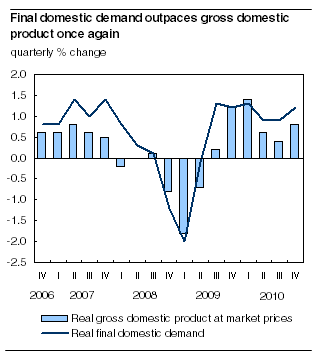
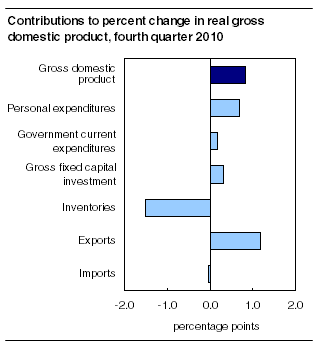
Exports rebound
After a slight drop (-0.4%) in the third quarter, the volume of exports of goods and services resumed the upward trend that began in the third quarter of 2009, increasing 4.0% in the fourth quarter.
Goods exports rose 4.9% and contributed the most to the gain in exports, with energy products (+17%) leading the way. Export volumes of crude petroleum rose 30% in the fourth quarter to a record high.
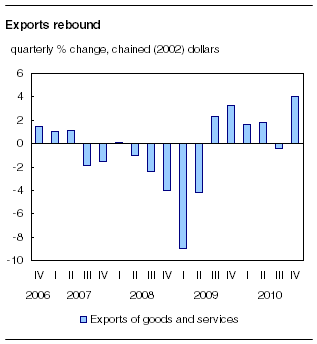
Exports of industrial goods and materials grew 8.1%, while exports of machinery and equipment increased for a third consecutive quarter.
Automotive exports declined 5.8%, dampening growth of total exports.
Imports slow
Growth in the volume of imports of goods and services slowed to 0.1%, the slowest rate of growth in six quarters, as automotive imports fell 5.2%.
Similarly, the growth of imports of machinery and equipment slowed to 0.2%, which was well off the pace of the previous three quarters.
Imports of services increased 2.6% as all major categories recorded gains.
Business investment in plant and equipment up
Business investment in plant and equipment increased 2.5% in the fourth quarter, its fourth consecutive gain. The main contributor was a 4.9% increase in investment in non-residential structures.
Growth in investment in machinery and equipment slowed to 0.2%, after three quarterly increases averaging 5.3%. The main contributors to the fourth quarter slowdown were lower investment in industrial machinery (-1.8%) and automobiles (-9.8%).
Inventories drawdown
Manufacturers' inventories, especially inventories of non-durable goods, fell markedly in the fourth quarter as did retail trade inventories. A large drawdown in motor vehicle inventories followed a build-up of motor vehicles in the first three quarters of 2010.
Consumer spending up
Consumer spending on goods and services rose 1.2% in the fourth quarter, up from 0.7% in the third quarter. Consumers increased their purchases of durable goods (+2.9%) and services (+1.3%).
Expenditures on new and used motor vehicles grew 3.8%, up from 1.4% in the previous quarter.
Spending on furniture, furnishings, and household equipment and maintenance increased 0.9%, after two quarters of decline.
Housing investment down again
Investment in housing edged down 0.2% in the fourth quarter, the second decline in a row. The value of new housing construction fell 5.7%, the first drop since the third quarter of 2009.
Renovation activity also fell, down 0.9% in the fourth quarter. Renovation activity has been weakening since the second quarter of 2010 after a string of quarterly increases of 3% or more that began in the second quarter of 2009.
In contrast, expenditure on ownership transfer costs related to housing resale activity was up 18%. This followed steep declines in the first three quarters of 2010.
Prices rise
The price of goods and services produced in Canada rose 0.9% in the fourth quarter.
Overall, the price of final domestic demand was up 0.5%, the same rate of increase as in the previous quarter.
Purchasing power expands
Canada's real gross domestic income, a measure of purchasing power, advanced 1.3% in the fourth quarter. Canada's terms of trade, which measures export prices relative to import prices, rose sharply in the fourth quarter, increasing 1.6% following a 0.8% decline in the third quarter.
Economy-wide incomes rise
Nominal GDP rose 1.7% in the fourth quarter. Labour income grew 1.4% as wages and salaries increased in both the goods-producing and services industries. Corporate profits increased 9.0%, up from 0.1% in the third quarter. Personal disposable income was up 1.8%.
The national saving rate was 4.8%, up from the third-quarter rate of 4.6%, as a result of increased saving in the persons and unincorporated business sector and in the corporate sector. Government saving has been negative since the fourth quarter of 2008.
Financial flows: Financing activity increases
Total funds raised by domestic non-financial sectors reached $243 billion (seasonally adjusted at annual rates) in the fourth quarter; this is up from $188 billion in the third quarter.
Borrowing by the government sector as a whole was up sharply, led by an increase in borrowing through short-term paper, despite the fact that the federal government reduced its borrowing.
Funds raised by non-financial private corporations amounted to $54 billion. Bonds were the major source of financing.
Household borrowing through mortgages advanced in the fourth quarter after slowing in the third quarter. This reflected increased housing resale activity.
The non-resident sector continued to be a net lender to the domestic economy in the fourth quarter. Non-resident investors continued to supply large inflows of funds to the economy primarily through investment in Canadian securities, especially corporate bonds and equities.
Gross domestic product by industry, December 2010
Real gross domestic product increased 0.5% in December after growing by 0.4% in November and 0.3% in October. As was the case in November, production increased in most major industrial sectors in December. Significant increases were recorded in oil and gas extraction, which accounted for nearly 40% of the overall increase, and in wholesale trade. Manufacturing, transportation, the public sector and the finance and insurance sector also grew. However, retail trade and construction contracted.
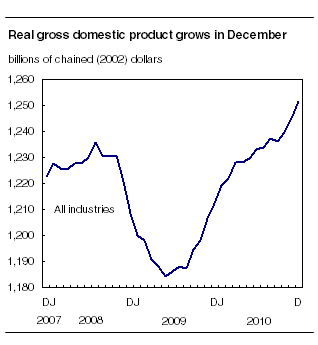
Primarily on the strength of oil and gas extraction, the mining sector increased 2.0% in December. Natural gas production rose significantly as demand south of the border increased. Oil extraction also went up on the strength of synthetic crude petroleum production. Metal ore mining declined partly as a result of unfavourable weather conditions and a return to more normal production levels in the nickel, copper, lead and zinc mines.
Wholesale trade grew 1.3% in December, partly reflecting the strength in exports. This marked a third consecutive monthly increase in wholesale trade. The majority of the subsectors reported growth in December, with the largest contribution coming from petroleum products. Conversely, retail trade fell 0.4% as activity declined at new and used car dealers and at food and beverage stores.
Manufacturing grew 0.6% in December, after three consecutive monthly declines. The production of both durable and non-durable goods increased. Motor vehicles production rose 6.2% following a decline in November. Manufacturers of paper, beverages and tobacco, machinery and chemicals also reported gains. Fabricated metal products manufacturing was down.
Construction activities decreased 0.3% as residential construction (-1.5%) continued to retreat. The output of real estate agents and brokers rose for a fifth consecutive month, reflecting a rise in sales of existing homes.
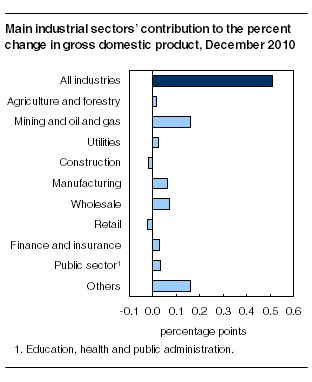
Products, services and contact information
Detailed analysis and tables
The National economic accounts module, accessible from the Key resource module of our website, features an up-to-date portrait of national and provincial economies and their structure.
Additional tables and links to other releases from the national accounts can be found in the fourth quarter 2010 issue of Canadian Economic Accounts Quarterly Review, Vol. 9, no. 4 (13-010-X, free). This publication is now available from the Key resource module of our website under Publications. This publication will be updated on March 15, at the time of the release of Labour productivity, hourly compensation and unit labour cost. Revised estimates of the Income and expenditure accounts for the first, second and third quarters of 2010 have been released, along with those for the fourth quarter of 2010. These estimates incorporate new and revised source data and updated estimates of seasonal patterns.
Gross domestic product by industry
Available on CANSIM: table 379-0027.
Definitions, data sources and methods: survey number 1301.
The December 2010 issue of Gross Domestic Product by Industry, Vol. 24, no. 12 (15-001-X, free), is now available from the Key resource module of our website under Publications.
Data on gross domestic product by industry for January will be released on March 31.
For more information, or to order data, contact the dissemination agent (toll-free 1-800-887-4623; 613-951-4623; iad-info-dci@statcan.gc.ca). To enquire about the concepts, methods or data quality of this release, contact Bernard Lefrançois (613-951-3622), Industry Accounts Division.
Income and expenditure accounts
Available on CANSIM: tables 026-0009, 380-0001 to 380-0017, 380-0019 to 380-0035, 380-0056, 380-0059 to 380-0062 and 382-0006.
Definitions, data sources and methods: survey numbers, including related surveys, 1901 and 2602.
The fourth quarter 2010 issues of National Income and Expenditure Accounts: Data Tables, Vol. 3, no. 4 (13-019-X, free), and Estimates of Labour Income: Data Tables, Vol. 3, no. 4 (13-021-X, free), are also now available from the Key resource module of our website under Publications.
For more information, or to enquire about the concepts, methods or data quality of this release, consult the Guide to the Income and Expenditure Accounts (13-017-X, free), or contact the information officer (613-951-3640; iead-info-dcrd@statcan.gc.ca), Income and Expenditure Accounts Division.
Financial flow accounts
Available on CANSIM: tables 378-0015 to 378-0048.
Definitions, data sources and methods: survey number 1804.
The fourth quarter 2010 issue of Financial Flow Accounts: Data Tables, Vol. 3, no. 4 (13-020-X, free), is also now available from the Key resource module of our website under Publications.
For more information, or to enquire about the concepts, methods or data quality of this release, contact the information officer (613-951-3640; iead-info-dcrd@statcan.gc.ca), Income and Expenditure Accounts Division.
- Date modified:
